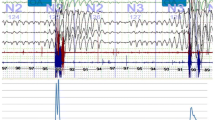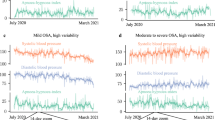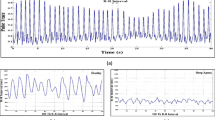Abstract
Background
Portable sleep apnea monitors are often used to screen for sleep-disordered breathing in chronic heart failure patients (CHF), but night-to-night repeatability of obtained measurements of nocturnal breathing disorders has not been fully assessed.
Methods
Fifty-six stable, moderate-to-severe CHF patients [male, 87%; age, 57 ± 9 years; NYHA class, 2.6 ± 0.6; left ventricular ejection fraction (LVEF), 32% ± 9%] underwent an unattended in-hospital cardiorespiratory recording using a portable sleep apnea monitor during two consecutive nights. The apnea/hypopnea index (AHI), apnea index (AI), oxygen desaturation index (ODI), and periodic breathing (PB) duration were computed. Intra-subject night-to-night variability was assessed by the 95% limits of random variation (LoV). We also estimated the contribution of intra-rater variability to the overall intra-subject variability. Dichotomizing the AHI and PB duration according to conventional cutoffs of, respectively, ≥5 events per hour, ≥15 events per hour, and ≥120 min, the percentage of patients concordantly classified by the two measurements was finally computed.
Results
The 95% LoV were ±10.6, ±7.7, ±11.3 events per hour for AHI, AI and ODI, and ±63.2 min for PB duration, respectively. The contribution of intra-rater variability to total intra-subject variability was 1.7%, 1.4%, 2.5%, and 1.3% for AHI, AI, ODI, and PB duration, respectively. Most patients (85%, 82%, and 95% for AHI ≥ 5, AHI ≥ 15, and PB duration, respectively) were classified concordantly by the two measurements.
Conclusions
In patients with heart failure, measurements of severity of sleep-disordered breathing derived from portable sleep apnea monitors show significant night-to-night intra-subject variation with a negligible contribution from intra-rater variability; however, using the same measurements for classification purposes, as commonly performed in clinical practice to screen patients for sleep-disordered breathing, very stable results are obtained.

Similar content being viewed by others
References
Oldenburg O, Lamp B, Faber L, Teschler H, Horstkotte D, Topfer V (2007) Sleep-disordered breathing in patients with symptomatic heart failure: a contemporary study of prevalence in and characteristics of 700 patients. Eur J Heart Fail 9(3):251–257
MacDonald M, Fang J, Pittman SD, White DP, Malhotra A (2008) The current prevalence of sleep disordered breathing in congestive heart failure patients treated with beta-blockers. J Clin Sleep Med 4(1):38–42
Pinna GD, Maestri R, Mortara A, Johnson P, Andrews D, Ponikowski P, Witkowski T, La Rovere MT, Sleight P (2010) Long-term time-course of nocturnal breathing disorders in heart failure patients. Eur Respir J 35(2):361–367
Javaheri S, ShuklaR ZH, Wexler L (2007) Central sleep apnea, right ventricular dysfunction, and low diastolic blood pressure are predictors of mortality in systolic heart failure. J Am Coll Cardiol 49(20):2028–2034
Ryan CM, Bradley TD (2005) Periodicity of obstructive sleep apnoea in patients with and without heart failure. Chest 127(2):536–542
Lanfranchi P, Braghiroli A, Bosimini E, Mazzuero G, Colombo R, Donner CF, Giannuzzi P (1999) Prognostic value of nocturnal Cheyne–Stokes respiration in chronic heart failure patients. Circulation 99:1435–1440
Corrà U, Pistono M, Mezzani A, Braghiroli A, Giordano A, Lanfranchi P, Bosimini E, Gnemmi M, Giannuzzi P (2006) Sleep and exertional periodic breathing in chronic heart failure: prognostic importance and interdependence. Circulation 113(1):44–50
Pinna GD, Maestri R, Mortara A, Johnson P, Andrews D, Ponikowski P, Witkowski T, Robbi E, La Rovere MT, Sleight P (2009) Pathophysiological and clinical relevance of simplified monitoring of nocturnal breathing disorders in heart failure patients. Eur J Heart Fail 11(3):264–272
Maestri R, Pinna GD, Robbi E, Varanini M, Emdin M, Raciti M, La Rovere MT (2002) RESP-24: a computer program for the investigation of 24-h breathing abnormalities in heart failure patients. Comput Methods Programs Biomed 68(2):147–159
Bland JM, Altman DG (1999) Measuring agreement in method comparison studies. Stat Methods Med Res 8(2):135–160
Fleiss JL. (1986) The design and analysis of clinical experiments. In: Wiley series in probability and mathematical statistics. Wiley, New York, pp 1–14
Atkinson G, Nevill AM (1998) Statistical methods for assessing measurement error (reliability) in variables relevant to sports medicine. Sports Med 26(4):217–238
Oldenburg O, Lamp B, Freivogel K, Bitter T, Langer C, Horstkotte D (2008) Low night-to-night variability of sleep disordered breathing in patients with stable congestive heart failure. Clin Res Cardiol 97(11):836–842
Vazir A, Hastings PC, Papaioannou I, Poole-Wilson PA, Cowie MR, Morrell MJ, Simonds AK (2008) Variation in severity and type of sleep-disordered breathing throughout 4 nights in patients with heart failure. Respir Med 102(6):831–839
Tkacova R, Niroumand M, Lorenzi-Filho G, Bradley TD (2001) Overnight shift from obstructive to central apneas in patients with heart failure: role of PCO2 and circulatory delay. Circulation 103(2):238–243
Pepin JL, Chouri-Pontarollo N, Tamisier R, Levy P (2006) Cheyne–Stokes respiration with central sleep apnoea in chronic heart failure: proposals for a diagnostic and therapeutic strategy. Sleep Med Rev 10:33–47
Author information
Authors and Affiliations
Corresponding author
Rights and permissions
About this article
Cite this article
Maestri, R., La Rovere, M.T., Robbi, E. et al. Night-to-night repeatability of measurements of nocturnal breathing disorders in clinically stable chronic heart failure patients. Sleep Breath 15, 673–678 (2011). https://doi.org/10.1007/s11325-010-0418-4
Received:
Revised:
Accepted:
Published:
Issue Date:
DOI: https://doi.org/10.1007/s11325-010-0418-4




